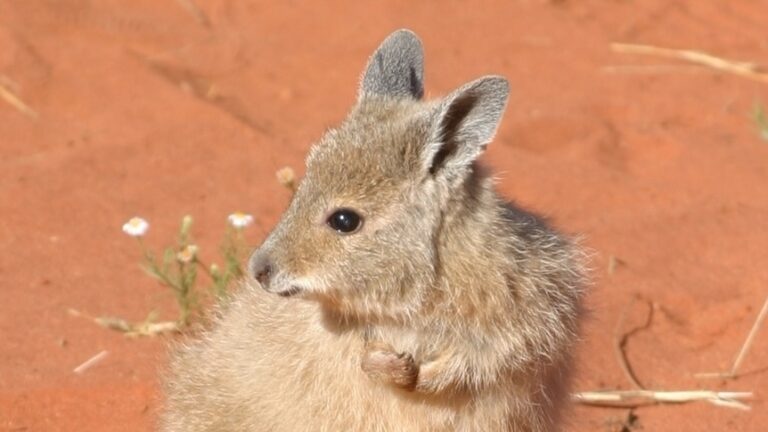
In the cool of the desert night near Uluru in Central Australia, Shaeleigh Swan and her colleagues have been counting malas.
Key points:
- Parks Australia says the Uluru mala wallaby population is now stable at 300
- Collaboration between six separate reserves helped prevent its extinction
- Conservationists say the species is a success story in midst of a national extinction crisis
“A mala is a furry little wallaby, about 15 centimetres high. They’re quite feisty little animals, but very cute,” she said.
Parks Australia staff have worked with Indigenous rangers and Anangu traditional owners to help save them from extinction.
By 1991 they were wiped out in the wild by feral cats, foxes and wildfire, then reintroduced to Uluru in a two square kilometre cat-proof fenced enclosure more than a decade later.
The 24 mala released in 2005 have now multiplied to 300.
“Anangu traditional owners chose to bring back the population of mala here because of the cultural significance, they helped to build the fencing, they also do a lot of the tracking, they do a lot of fire management,” said Ms Swan, who is Parks Australia’s Indigenous Engagement Manager.
“And we’ve been able to keep our enclosure predator free and also ensuring that our population are healthy and ensuring there’s no diseases.”
Along with five similar projects, Parks Australia and the Anangu have helped to increase the national population of mala to about 900.
Animals are swapped between sanctuaries to prevent inbreeding. But the mala and other animals still face increasing threats.
“Climate change has a really high impact on threatened species,” Ms Swan said.
“Now we get hotter months of the year where we get higher risks of wildfires burning hotter, also higher rains where we get more erosion in the landscape as well.
“We’re getting forecasts of at least a degree hotter every year, over the last decade or so, more temperatures in the 40s.
“Droughts are now lasting longer than previous years.”
‘Australia is a leader in mammal extinction’
The World Wildlife Fund’s species conservation manager Darren Grover said the mala was a success story in an otherwise poor picture.
“Sadly and shamefully, Australia is a leader in mammal extinction, we’ve had over 30 mammals go extinct since the arrival of Europeans in Australia,” he said.
The federal government’s July 2022 State of the Environment assessment found the number of species under threat has increased by eight per cent since 2016.
It found the situation was continuing to deteriorate because of climate change, habitat loss, feral animals, weeds, pollution and mining.
In response, the government has promised to more actively enforce biodiversity laws, double Indigenous ranger numbers and protect 30 per cent of the Australian landscape.
“We need to use things like recovery plans which identify for each species or for groups of species, Mr Grover said.
“What are the most important parts of the range of that species that need to have that highest level of protection.”
The Australian Conservation Foundation’s Kelly O’Shanassy said more money was also needed.
“Australia now has some of the strongest nature protection commitments in the world, the trick is to turn those into action,” she said.
“We need about $2 billion of spending a year to help threatened species recover, right now there’s only about a couple of hundred million dollars being put into that.”
At Uluru, the Anangu are celebrating the wins.
“Managing the land using traditional knowledge as well as science, it’s definitely great to see that all work together,” Ms Swan said.
“We hope for that every day, for all of our threatened species, and that we can have a better environment, with less threat from climate change, it’s all one step at a time.”